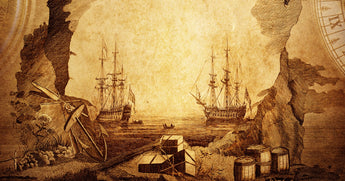Coffee’s story begins with a happy accident in the 9th century. The legend goes that an Ethiopian goat herder named Kaldi noticed his goats were unusually energetic after munching on strange red berries. Curious about the effect, Kaldi tried them himself and felt an instant surge of energy. He shared his discovery with local monks, who brewed the berries into a drink to help them stay awake during long prayers. This early form of coffee quickly became a religious and cultural ritual in Ethiopia.
By the 15th century, coffee had spread across the Arabian Peninsula, especially in Yemen, where it became deeply integrated into daily life. The first coffeehouses, known as qahveh khaneh, opened in the Middle East and soon became vibrant centers for social interaction. Coffee was consumed not only for its energizing effects but also for the conversations and intellectual exchanges that took place within these establishments. It was here that coffee began its rise as a beverage of connection, learning, and creativity.

When coffee reached Europe in the 17th century, it was met with mixed reactions. Some religious figures feared its energizing effects, calling it the “Devil’s Drink,” but when Pope Clement VIII tasted it, he loved it and blessed the drink. This was the turning point for coffee in Europe. Coffeehouses began popping up in cities like London, where they were called “penny universities” because anyone could enjoy a cup of coffee while discussing politics, philosophy, and science. Coffee was now part of the social fabric of Europe, and it was only getting started.
By the time coffee reached the Americas, the demand for it was unstoppable. Coffee production expanded rapidly, especially in Brazil, where the climate proved perfect for cultivating coffee beans. By the 19th century, Brazil had become the world’s largest coffee producer. Coffee soon became a vital part of the global economy, fueling the Industrial Revolution and helping to power workers through long hours. With coffee now produced in large quantities, it was more accessible than ever before.

The 20th century marked a major turning point for coffee. The invention of instant coffee in the early 1900s made it easier for people to enjoy coffee at home, without the need for special equipment. Then, in the 1940s, the invention of the espresso machine forever changed the way coffee was brewed. Coffeehouses began to adopt new technologies, and by the 1970s, Starbucks opened its first store in Seattle, popularising coffee as a lifestyle and making it an essential part of modern culture. Coffee was no longer just a drink—it was now a cultural experience.
As we moved into the 21st century, coffee lovers became more discerning than ever before. With the rise of the specialty coffee movement, people began to seek out higher-quality, ethically sourced beans and began appreciating the art of brewing. Coffee culture shifted from mass production to artisanal craftsmanship, with roasters focusing on the quality of the beans, the process of roasting, and the method of brewing. Whether it was a perfectly brewed espresso or a beautifully frothed cappuccino, coffee became more than a mere caffeine fix—it was now a fine art.

Today, coffee is more accessible than ever, with endless options to suit every taste. Whether you're brewing a rich espresso, crafting the perfect cappuccino, or enjoying a smooth cup of filter coffee, there’s a coffee for every mood. We offer an impressive range of coffee capsules, including Nespresso, Dolce Gusto, and more, ensuring you can enjoy your favourite brew in a snap. Plus, our selection of freshly roasted beans and premium filter coffee offers a delicious experience for those who prefer to take their coffee to the next level.
Whether you prefer capsules, beans, or filter coffee, our wide range has something for everyone. Shop our full collection today and enjoy delicious, affordable coffee that makes every cup a moment to savour!
















